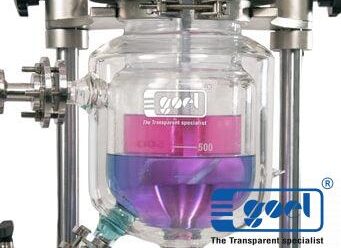Reaction Units
Reaction Units
Chemistry labs, Pharmaceutical labs often require mixing different types of chemicals in order to create new compounds. This process can be dangerous because it requires handling flammable liquids and gases. To prevent accidents, you need a glass reaction units that will allow you to safely mix these substances.
Related Products
The Ultimate Guide To Buying The Perfect Glass Reaction Units
A glass reaction units is an essential piece of equipment for any chemistry lab. It allows you to safely mix chemicals without spilling or burning yourself.
Chemistry labs, Pharmaceutical labs often require mixing different types of chemicals in order to create new compounds. This process can be dangerous because it requires handling flammable liquids and gases. To prevent accidents, you need a glass reaction unit that will allow you to safely mix these substances.
What Is A Glass Reaction Unit?
A glass reaction unit (also known as a glass vessels) is a container used to store and mix chemical solutions. They come in various sizes and shapes, but they all work similarly. You place the solution inside the glass vessel and then add the other ingredients. Once everything has been mixed together, you remove the lid and let the mixture cool down before using it.
A glass reaction unit is a convenient and safe way to handle these processes. But, before you make a purchase, you’ll need to understand the different types of units and how to choose one for your particular needs. You’ll also need to take several other factors into account. By considering all these aspects, you’ll be able to choose a reaction unit that will meet your laboratory’s requirements.
Glass Reaction Units Types
There are several different types of glass reaction units available on the market:

Standard Units: These are the most common type of glass reaction unit. They come in a variety of shapes and sizes, so you can find one that suits your needs. Standard units typically have two necks, which allow you to add and remove chemicals without spillage. Some models also come with stoppers or lids, to further prevent accidents.

Jacketed Units: Jacketed units are similar to standard units, but they have an additional layer of protection. This extra layer helps to keep the contents at a constant temperature, which is important for some chemical reactions. jacketed units also tend to be larger than standard units, so they’re ideal for larger labs.

Pressure Vessels: Pressure vessels are designed to withstand high pressures. They’re often used in reactions that involve gases or volatile liquids. pressure vessels come in a variety of shapes and sizes, and they can be made from different materials (including stainless steel and Hastelloy and Borosilicate Glass). Choose a pressure vessel that’s rated for the maximum pressure you expect to encounter in your experiments.
As you can see, there are many different types of glass reaction units available on the market today. Each type has its own advantages and disadvantages, so it’s important to choose the right one for your needs.
Take into consideration the type of chemical reactions you’ll be performing as well as the size and scope of your laboratory before making a purchase
When it comes to choosing the right glass reaction unit for your lab, there are a few things you need to take into account.
First, consider the type of reactions you’ll be performing. Different reaction units are better suited for different types of reactions.
For example, standard units are typically used for mixing chemicals, while jacketed units are better for reactions that require constant temperature control.
Next, think about the size of your laboratory.
You’ll need to choose a unit that’s large enough to accommodate all the chemicals you’ll be using in your experiments.
Jacketed units tend to be larger than standard units, so they’re ideal for expansive labs.
Finally, keep in mind the materials your Reaction vessel will be made from. The most common options are stainless steel and borosilicate glass, but there are also pressure vessels made from Hastelloy and other materials.
Choose a material that can withstand the maximum pressure you expect to encounter in your experiments.
There are a few key things to consider when choosing the right glass reaction unit for your laboratory. First, think about the types of reactions you’ll be performing.
Different units are better suited for different types of reactions. For example, standard units are typically used for mixing chemicals, while jacketed units are better for reactions that require constant temperature control.
Next, consider the size of your laboratory. You’ll need to choose a unit that’s large enough to accommodate all the chemicals you’ll be using in your experiments.
Jacketed units tend to be larger than standard units, so they’re ideal for expansive labs.
Finally, keep in mind the materials your Reaction vessel will be made from. The most common options are stainless steel and borosilicate glass, but there are also pressure vessels made from Hastelloy and other materials.
Choose a material that can withstand the maximum pressure you expect to encounter in your experiments.
By considering all these factors, you can choose a glass reaction unit that’s perfect for your needs
Our Products
- Industrial Glassware
- Glass Pipeline Components
- Glass Reactor
- Couplings
- Kilo Lab
- ASSEMBLIES OVER GLASS LINED REACTOR
- DISTILLATION APPARATUS
- Distillation Glassware
- Essential Oil Distillers
- Extraction Unit
- Flanged Reactor
- FRACTIONAL DISTILLATION UNIT
- HCL Adiabatic Absorption
- JACKETED GLASS REACTOR
- METAL JACKETED GLASS REACTOR
- Mobile Mixing System
- PILOT PLANT/ MULTI PURPOSE UNIT
- REACTION DISTILLATION Unit
- SOLVENT EXTRACTION
- VACUUM DISTILLATION
- Glass Column
- Technical Packages
- Heat Exchangers
- Rotary Evaporator
- Glass Valves
- Structure and Support
- Stirrers
- Sight Glass
- Measurement and Control
- Jumbo Rotary Film Evaporator
- Laboratory Glassware
- Popular Products

